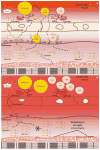Pathophysiology of sepsis-related cardiac dysfunction: driven by inflammation, energy mismanagement, or both?
- PMID: 25475180
- PMCID: PMC4474734
- DOI: 10.1007/s11897-014-0247-z
Pathophysiology of sepsis-related cardiac dysfunction: driven by inflammation, energy mismanagement, or both?
Abstract
Sepsis is a systemic inflammatory response that follows bacterial infection. Cardiac dysfunction is an important consequence of sepsis that affects mortality and has been attributed to either elevated inflammation or suppression of both fatty acid and glucose oxidation and eventual ATP depletion. Moreover, cardiac adrenergic signaling is compromised in septic patients and this aggravates further heart function. While anti-inflammatory therapies are important for the treatment of the disease, administration of anti-inflammatory drugs did not improve survival in septic patients. This review article summarizes findings on inflammatory and other mechanisms that are triggered in sepsis and affect cardiac function and mortality. Particularly, it focuses on the effects of the disease in metabolic pathways, as well as in adrenergic signaling and the potential interplay of the latter with inflammation. It is suggested that therapeutic approaches should include combination of anti-inflammatory treatments, stimulation of energy production, and restoration of adrenergic signaling in the heart.
Conflict of interest statement
Figures


Similar articles
-
Mechanisms of sepsis-induced cardiac dysfunction.Crit Care Med. 2007 Jun;35(6):1599-608. doi: 10.1097/01.CCM.0000266683.64081.02. Crit Care Med. 2007. PMID: 17452940 Review.
-
Cardiac dysfunction, mitochondrial architecture, energy production, and inflammatory pathways: Interrelated aspects in endotoxemia and sepsis.Int J Biochem Cell Biol. 2016 Dec;81(Pt B):307-314. doi: 10.1016/j.biocel.2016.07.032. Epub 2016 Jul 28. Int J Biochem Cell Biol. 2016. PMID: 27477311 Review.
-
[Heart in sepsis : Molecular mechanisms, diagnosis and therapy of septic cardiomyopathy].Anaesthesist. 2017 Jul;66(7):479-490. doi: 10.1007/s00101-017-0329-x. Anaesthesist. 2017. PMID: 28677016 Review. German.
-
The heart in sepsis: from basic mechanisms to clinical management.Curr Vasc Pharmacol. 2013 Mar 1;11(2):187-95. Curr Vasc Pharmacol. 2013. PMID: 23506497 Review.
-
Cardiac dysfunction in critical illness.Curr Opin Anaesthesiol. 2018 Apr;31(2):158-164. doi: 10.1097/ACO.0000000000000572. Curr Opin Anaesthesiol. 2018. PMID: 29351144 Review.
Cited by
-
GSDMD Mediates LPS-Induced Septic Myocardial Dysfunction by Regulating ROS-dependent NLRP3 Inflammasome Activation.Front Cell Dev Biol. 2021 Nov 8;9:779432. doi: 10.3389/fcell.2021.779432. eCollection 2021. Front Cell Dev Biol. 2021. PMID: 34820388 Free PMC article.
-
Central venous pressure value can assist in adjusting norepinephrine dosage after the initial resuscitation of septic shock.Chin Med J (Engl). 2019 May 20;132(10):1159-1165. doi: 10.1097/CM9.0000000000000238. Chin Med J (Engl). 2019. PMID: 30946069 Free PMC article.
-
Accelerated Autophagy of Cecal Ligation and Puncture-Induced Myocardial Dysfunction and Its Correlation with Mammalian Target of Rapamycin Pathway in Rats.Chin Med J (Engl). 2018 May 20;131(10):1185-1190. doi: 10.4103/0366-6999.231522. Chin Med J (Engl). 2018. PMID: 29722337 Free PMC article.
-
Research progress on the activation mechanism of NLRP3 inflammasome in septic cardiomyopathy.Immun Inflamm Dis. 2023 Oct;11(10):e1039. doi: 10.1002/iid3.1039. Immun Inflamm Dis. 2023. PMID: 37904696 Free PMC article. Review.
-
Long-term impact of sepsis on cardiovascular health.Intensive Care Med. 2019 Jan;45(1):78-81. doi: 10.1007/s00134-018-5173-1. Epub 2018 May 8. Intensive Care Med. 2019. PMID: 29740669 Free PMC article.
References
-
- Lagu T, Rothberg MB, Shieh MS, et al. Hospitalizations, costs, and outcomes of severe sepsis in the United States 2003 to 2007. Crit Care Med. 2012;40:754–61. - PubMed
-
- Angus DC, Linde-Zwirble WT, Lidicker J, et al. Epidemiology of severe sepsis in the United States: analysis of incidence, outcome, and associated costs of care. Crit Care Med. 2001;29:1303–10. - PubMed
-
- Annane D, Bellissant E, Cavaillon JM. Septic shock. Lancet. 2005;365:63–78. - PubMed
-
- Levy MM, Fink MP, Marshall JC, et al. 2001 SCCM/ESICM/ACCP/ATS/SIS international sepsis definitions conference. Crit Care Med. 2003;31:1250–6. - PubMed
-
- Zaky A, Deem S, Bendjelid K, Treggiari MM. Characterization of cardiac dysfunction in sepsis: an ongoing challenge. Shock. 2014;41:12–24. - PubMed
Publication types
MeSH terms
Substances
Grants and funding
LinkOut - more resources
Full Text Sources
Other Literature Sources
Medical

